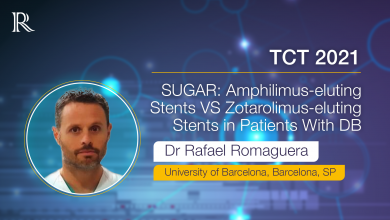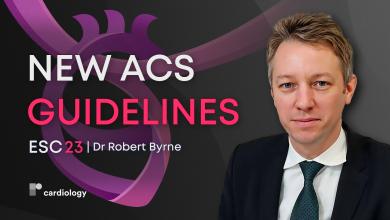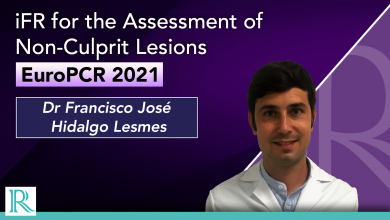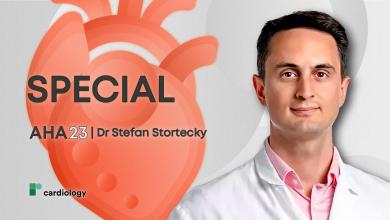Search results
Author(s):
William Fearon
Added:
2 years ago
In this short interview, Dr William F Fearon (Stanford University School of Medicine, US) discusses the findings from the FAME3 trial. This multicenter, international, randomized, controlled noninferiority trial investigated whether fractional flow reserve (FFR)-guided percutaneous coronary intervention (PCI) in patients with multivessel coronary artery disease (CAD) will result in similar…
View more
Author(s):
Rafael Romaguera
Added:
2 years ago
In this short interview, Dr Rafael Romaguera (University of Barcelona, SP) discusses the findings from the SUGAR trial.This randomized head-to-head trial aimed to compare Cre8 EVO stents to a contemporary drug-eluting stent (DES) in patients with diabetes (DM) and coronary artery disease. The trial, first presented at TCT 2021, demonstrated that Cre8 EVO stents were non-inferior to Resolute Onyx…
View more
Author(s):
Robert A Byrne
Added:
7 months ago
ESC 2023 — Dr Robert Byrne (Mater Private Hospital, Dublin, IE) joins us on-site to discuss the new guidelines from the ESC covering the management of acute coronary syndromes.
Acute Coronary Syndrome (ACS) is a broad spectrum of conditions, and the presentation can vary from a stable patient, to a patient who is critically ill. In the past, separate guidelines were issued for ST-Elevation…
View more
Author(s):
Francisco Hidalgo
Added:
2 years ago
In this interview, Dr Francisco José Hidalgo Lesmes (University Hospital Reina Sofia, Cordoba, ES) outlines the findings of a multicenter observational registry evaluating the use of instantaneous wave-free ratio for the assessment of non-culprit lesions in patients with acute coronary syndrome.
Questions:
What was the rationale for this study?
Can you describe the design, patient population and…
View more
Author(s):
Stefan Stortecky
Added:
5 months ago
AHA 23 — We are joined onsite by Prof Stefan Stortecky (Bern University Hospital, Bern, SE) to discuss the findings of the single centre SPECIAL trial that investigated ultrasound-assisted catheter-directed thrombolysis as compared to surgical pulmonary embolectomy for intermediate high or high risk pulmonary embolism.Questions1. What is the reasoning behind this study?2. What is the patient…
View more
Sex, Drugs, MVD, rSS and STEMI
Author(s):
Sonya Burgess
,
Craig P Juergens
,
Wesley Yang
,
et al
Added:
1 year ago
Article
Author(s):
Martha Gulati
,
Cara Hendry
,
Biljana Parapid
,
et al
Added:
2 years ago
Author(s):
Mahmoud Abdelnabi
,
Nouran Eshak
,
Yehia Saleh
,
et al
Added:
3 years ago
Pathophysiology of COVID-19-related Cardiac Injury
Acute myocarditis is a potentially life-threatening disease, which is most commonly caused by a viral infection. Among the viruses, the most cited are enteroviruses (especially coxsackievirus), adenovirus and parvovirus B19 and, rarely, coronavirus.
Recently, coronavirus disease 2019 (COVID-19), which is caused by severe acute respiratory…
View more
Author(s):
Stephen Ralph Large
,
David Phillip Jenkins
Added:
3 years ago
There is emerging clarity in the management of pulmonary embolism (PE) as information has been collated to form guidelines addressing its diagnosis and management.1 This is appropriate as PE is common, and was observed in 18% of all autopsies in a recent Swedish study,1 with an incidence in hospital patients of 0.4%. It has a mortality rate of 7–11%,1 killing up to 10% of patients within the…
View more
Author(s):
Patrycja Ganslmeier
,
Christof Schmid
Added:
3 years ago
End-stage heart failure is a leading cause of death of modern society. In the US almost five million people suffer from heart failure, with an annual incidence of 500,000 new cases. About 10% of the population beyond 70 years of age are affected (www.nhlbi.nih.gov). Estimations for Europe amount to 10 million and heart failure has overtaken cancer as the leading cause of death (www.destatis.de)…
View more

















 « First
« First